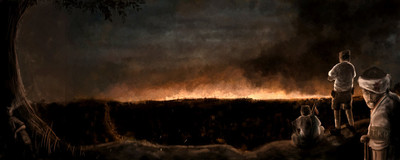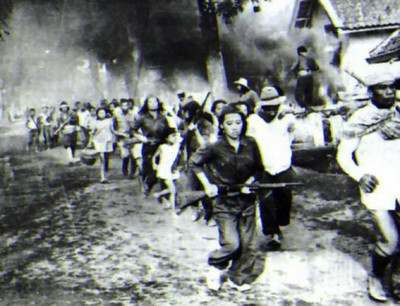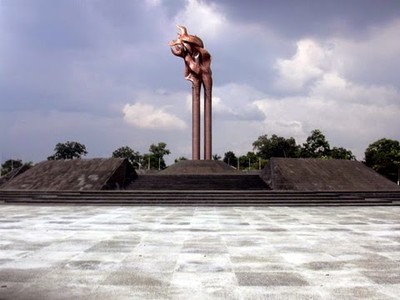This text is based on a conversation between Gal Kirn and Lidwien van de Ven on the topic of the Sea of Fire, or the Burning of Bandung.
Burning of the City as a Start of Anti-colonial Struggle
Sea of Fire, or what is called Bandung Lautan Api, emerged in the context of a still fresh occupation by imperial Japanese forces in World War II. Indonesian combatants who fought off the Japanese occupation received an ultimatum on March 24th, 1946 by British forces and Dutch Army Troops to disarm or leave the city. The Indonesian resistance found itself under the layering of different colonial oppressions, and as a response to this ultimatum around 200.000 inhabitants burned their homes. One cannot confirm the precise number, but most of the Southern part of Bandung was burned. The old houses are currently located in the Northern part of the city. A story goes that it was a young journalist Atje Bastaman who witnessed the burning of Bandung from Mount Leutik, a hill around Paeunpeuk, and saw how Bandung turned red. This made it into the headlines: "Bandoeng Djadi Laoetan Api ", though due to lack of space was shortened to "Bandoeng Laoetan Fire".
The burning of the city followed a strategic decision by residents to not only flee the city, but to also prevent the Dutch Army Troops and the British Allies from taking full control in the citizen’s place. The city was taken back for a short period, but had to be left behind again for forests and for undetermined time. The strategy of burning parts of the city is reminiscent of guerrilla fighting, which takes place in urban surroundings, and can lead to riots and ultimately burning: be it historically through the symbolic burning connected to the food and stores that decided to raise the price of bread and other necessities; buildings that represent local symbols of power, such as job centers and police station; or police/colonial vehicles.
In the case of the Sea of Fire the political act of burning was radicalized, as it was connected to the space one holds dearest. This is not only how resistance takes place and people gain the time necessary to leave the city, but allows for the demonstration of political will: the occupiers will not be able to really occupy our space, live in our houses, we would rather burn our homes than live in these homes under foreign occupation. No matter how strategic the decision to burn Bandung was, some combatants stayed in the city and fought the occupation forces. One specific action, the suicide of Mohammad Toha, is worth recollecting. Toha was a member of the Indonesian militia and succeeded in smuggling several sticks of dynamite into the Dutch military Headquarters in Dayeuh Kolot. Once inside he was able to detonate the dynamite amongst warehouses of ammunition, killing himself and several Dutch and Japanese troops in the vicinity. The explosion created a small lake in Dayeuh Kolot, which triggered the metonymic vision of a lake and fire.
While retreating to the countryside, Ismail Marzuki was inspired by the Sea of Fire and added twist to his well-known poem, by altering last sentences of the song “Halo, Halo Bandung”. This became a popular song at the time. Meanwhile Bandung has since the postcolonial times, organizes yearly commemorations around monuments and locations in the city that relate to the events of 1946.
Hello, Hello Bandung
The capital of Parahyangan
For so long I’m in distance, I cannot see
Hopefully now we meet again
And after that, no more inquisitive feeling.
Hello, Hello Bandung, a city of full of memory.
For so long, I want to meet you.
Whilst my soul and desire in my body
We will meet again.
Hello, Hello Bandung, the capital of Periangan
Hello, Hello Bandung, a city full of memory
Now, she has become a Sea of Fire.
Lets reclaim her again, Bung (comrade).
1946 news: "How extremist leave behind South-Bandung"


